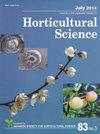Effects of the Timing of Fertilizer Application on the Number of Flowers of Japanese Pepper
Journal of The Japanese Society for Horticultural Science
Pub Date : 2013-01-01
DOI:10.2503/JJSHS1.82.11
引用次数: 0
Abstract
This study was conducted in three consecutive years to determine the appropriate timing of fertilizer application to increase the flower number of the Japanese pepper, Zanthoxylum piperitum (L.) DC. f. inerme Makino (known as ‘Budousanshou’ in Japan) cultivated in Wakayama Prefecture. The timing experiment involved three treatment options: fertilizer application in spring with two equal applications in May and June, a summer/autumn treatment of two equal applications in August and September, or a spring/summer/autumn treatment of four equal applications in May, June, August, and September. Each treatment consisted of an annual application of 300 kg ⋅ ha − 1 nitrogen. The spring treatment resulted in increased flower number. It was suggested that the application of fertilizer in the May/June spring treatment resulted in a focused accumulation of nutrients prior to the floral evocation period and led to the subsequent increase in flower number and cluster number relative to the summer/autumn and spring/summer/autumn treatments.施肥时机对日本辣椒花数的影响
本研究连续3年进行,以确定适当的施肥时间,以增加日本辣椒花椒(Zanthoxylum piperitum, L.)的开花数量。直流。在和歌山县种植的牧野(在日本被称为“budousanshow”)。时间试验包括3种处理方案:春季施肥,5月和6月各等量施肥;夏/秋施肥,8月和9月各等量施肥;春/夏/秋施肥,5月、6月、8月和9月各等量施肥。每个处理每年施用300 kg⋅ha−1氮肥。春季处理导致花数增加。结果表明,春、五、六月处理在花的召唤期之前集中积累养分,导致花的数量和簇的数量相对于夏、秋和春、夏、秋处理有所增加。
本文章由计算机程序翻译,如有差异,请以英文原文为准。
求助全文
约1分钟内获得全文
求助全文
来源期刊
自引率
0.00%
发文量
0
审稿时长
>36 weeks

 求助内容:
求助内容: 应助结果提醒方式:
应助结果提醒方式:


